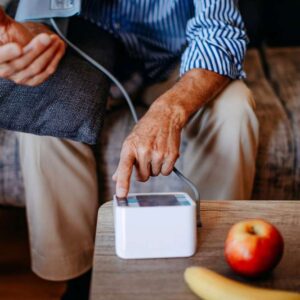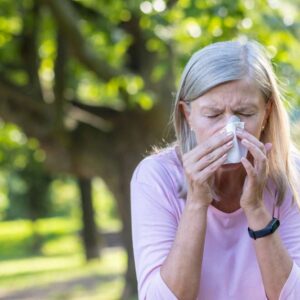
Three Things You Need to Know About Sunscreen
- Discover the only three ways known to reduce your chances of skin cancer
- Are you getting an extra side of cancer or hormones with your sun protection? Find out more…
- Two sunscreens you can feel good about using.
Dear Living Well Daily Reader,
“Honestly, given your fair complexion… it could be skin cancer. We won’t know until we get the biopsy result.”
This was the last sentence I ever expected to hear at age 22.
As I sat in the dermatologist exam room staring at the fresh stitches in my arm, I thought to myself, There’s no way this is happening to me. I am too young! I don’t go to tanning beds, and I always use sunscreen!
After a few minutes, I pulled it together and drove back to work.
But by the end of the day, after reading that melanoma kills one person in the United States every minute — I had planned my funeral.1
Since I had spent most of my life up until this point under the blazing rays of the Florida sun, I thought there was a great possibility this biopsy would come back positive. I felt totally powerless as I sat around and waited for the results.
Finally, about a week later, my dermatologist called to report that I was totally cancer-free and that the mole they had taken was simply an “unusual growth.” She also added that I needed to maintain a strict sun protection regimen if I wanted to remain skin cancer-free
Her recommendation?
More sunscreen, of course.
And just like me, you’ve probably been told your whole life sunscreen is the only way to protect yourself from cancer-causing sun exposures.
But about 10 years ago, after I had this scare, I started to wonder if all the trouble I went to applying and re-applying was even working.
Does this stuff actually protect me? Or is this smelly goop just a placebo?
As it turns out, there might have been some truth in my skepticism. We will get to that in just a bit.
My doubt deepened when I realized I knew lots of folks who religiously slathered themselves in this artificial coconut-smelling emulsion but still had run-ins with skin cancer.
And shortly thereafter, I figured out there is a good reason for my doubt — skin cancer is on the rise.
 Potent Rays
Potent Rays
According to the National Cancer Institute, since the 1970s, the rate of new melanoma cases has tripled, from 7.9 per 100,000 to 24 per 100,000.2
And while science hasn’t been able to put a fine point on the cause of melanoma, there are a few things that increase your risk: indoor tanning, freckles and moles, fair skin, severe sunburns, and UV radiation.
Of these, the only things you can control are indoor tanning, severe sunburns, and UV radiation exposure.
Obviously, indoor tanning is easily avoidable — just don’t do it.
But severe sunburns and UV exposure are a little trickier if you spend time outdoors.
So in hopes of avoiding these factors, you probably make your contribution to the $399 million-a-year sun care products business like most folks.
The problem is you might be spending all that money on a product that’s doing you more harm than good and all the while taking your money.
You see, every major public health authority, including the FDA and National Cancer Institute, concludes that there isn’t sufficient data to prove that sunscreens along can reduce your chance of getting skin cancer.3
Furthermore, sunscreens contain toxic chemicals that can cause cancer.
Today, in an effort to help you get safe sun protection, I am going to share with you three things you need to know about sunscreen, including best buying practices.
Let’s get started…
Three Things You Need to Know About Sunscreen
- Some sunscreens are full of dangerous chemicals
- Suncreens use either chemical or mineral UV filters. Chemical filters include oxybenzone, avobenzone, octisalate, homosalate, octocrylene, and octinoxate. While none of these chemicals are good for you, perhaps the most worrisome of the lot is oxybenzone. Oxybenzone can mimic hormones and also cause skin allergies. Plus, research from the CDC has found that more than 96 percent of Americans have oxybenzone in their bodies.
- In addition, oxybenzone is lethal to coral reefs. In fact, the chemicals in just one drop of sunscreen can wreak havoc on coral reef systems.4 While you’re not a tiny sea creature, the fact that these chemicals have to power to kill other living thing might make you think twice about slathering it all over your body.
- A Common sunscreen additive may speed up cancer development
- Some sunscreens contain vitamin A. Also known as retinyl palmitate, retinyl acetate, retinol, and retinyl linoleate, vitamin A has proven to be a cause of the development of skin tumors and lesions when used on skin in sunlight, according to studies performed by the U.S. federal government.
- Due to these dangers, it’s best to avoid any product with one of these additives.
- Sunscreen doesn’t combat all types of sun damage
- While SPF represents protection from sunburn, it does not indicate a measure for any other type skin damage. UV rays can also create DNA -damaging free radicals. These tiny terrors can also lead to skin aging and skin cancer.
- Sunscreens capable of filtering UVA light can help protect you from this type of damage. Avobenzone, a common UVA filter in sunscreens, can be broken down by UV rays. However, zinc oxide is a strong UVA filter. Zinc or mineral-based sunscreens make a better choice in this arena.
To sum things up, I have made a list of things to look for when purchasing sunblock:
- Chemical-free
- Mineral-based
- Vitamin A-free
- And as always, non-GMO.
Of all the brands out there, Living Well recommends just two: All Good and ButterBean Organics sunblocks.
Both of these choices are:
- Made with organic ingredients
- Chemical-free
- Mineral-based
- Biodegradable
- Non-GMO
- Vitamin A-free
- Top-rated by EWG.
For more information, please click here for All Good and here for ButterBean Organics.
Live well,

Natalie Moore
Managing editor, Living Well Daily
Sources
[1] Skin Cancer Facts and Statistics
[2] Table 16.5: Melanoma of the Skin (Invasive)
[3] Eight Little-Known Facts About Sunscreens
[4] Chemicals In Sunscreen Are Harming Coral Reefs, Says New Study
Written By Natalie Moore
Natalie Moore is a dedicated health researcher with a passion for finding healthy, natural, and science-based solutions. After a decade of direct healthcare experience in western and natural medicine, she was involved in public health research before joining Living Well Daily.
View More Free Articles
Can't Shake Negative Thoughts? Check Your GUT First
Everyone struggles sometimes to stay positive or see the bright side of things. It’s part of being human. You might think those negative thoughts start in your brain—but it’s more complicated than that. A simple change to your daily habit can help dial down those negative feelings. New research suggests that this simple strategy could...
Repair Your Gut Barrier With the “Sunshine Cure”
Happy Fourth of July! As you celebrate with sunshine, good food, and great company, don’t forget—those summer rays aren’t just lifting your spirits… they’re also working behind the scenes to protect your gut and boost your health. Your gut health is more important than most people realize. It directly affects your overall well-being—from immunity to...
The 5 Health Numbers Your Doctor Wishes You'd Track
Have you ever been told you should “advocate” for yourself when it comes to your healthcare and wondered what that really means? It’s not just a buzzword—it’s a powerful concept that empowers you to take charge of your own health journey. In fact, it could save your life. Being your own best health advocate starts...
Do THIS Every 20 Minutes to STOP Digital Eye Strain
Our eyes are under assault—they are the true victims of our current digital age. And it’s because we are constantly glued to screens… phones, tablets, computers, TVs—you name it. Unfortunately, that screen time is taking a serious toll. Digital eye strain affects millions worldwide. In fact, up to 50 percent of computer users could develop...
Mailbag: The Calcium Mistake That's Hardening Your Arteries
“What type of calcium is best to take with bisphosphonates for osteoporosis? I know some varieties can build up in arteries. Thanks for the help.” —Bone Builder Hi Builder, When a patient asks me about calcium, I ask them a peculiar question in return… “Ever wonder how elephants and giraffes build and maintain their massive...
Doctor-Approved Method to Ditch Blood Pressure Meds
In a world where drug solutions dominate healthcare, it’s refreshing to discover that best remedies sometimes don’t involve a single pill. A groundbreaking study shows simple relaxation techniques could be your secret weapon against one of America’s deadliest health conditions. Best of all? It’s free, easy to start right away—and your results are bound to...
Trouble Hearing? Your Heart Could Be at Risk
With research exploding and data pouring in, scientists are uncovering some weird (and surprisingly helpful) health connections. Today’s odd couple? Hearing loss and heart failure. Turns out your ears and your ticker are more connected than you ever imagined. A major study published in the journal Heart looked at over 164,000 people for nearly a...
Stay Up Late? It Could Destroy Your Mental Health
If you dread mornings but come alive at night, there’s concerning new research you need to know about. A recent study found that “night owls” are at higher risk for depression. But before you rush to set your alarm to get up with the sun tomorrow, there’s more to the story… Chronotypes are essentially your...
Go from Flabby to Fit with this Common Vitamin
If you’re like many of us, you woke up one day, looked in the mirror, and realized you’re no spring chicken anymore. Even worse—when you weren’t paying attention—it seems you somehow misplaced the muscles of your youth and have gone from fit to flabby. Aging has a way of humbling us like that. But scientists...
Seasonal Allergy “Off Switch” Discovered in the GUT
“Doc, why am I suddenly suffering from seasonal allergies when I’ve never had them before?” It’s a question I get all the time—and my answer might surprise you. Stop looking up at the trees—and start looking down at your gut… Your sneezing fits, itchy eyes, and runny nose might have more to do with what’s...









